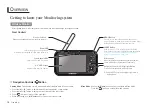
ProAir 2200
ENMET
Manual Revision Date – May 3, 2017
P a g e
|
13
Manual Part No. – 80002-046
4.3 Alarm Latching or Differential Settings
An instrument is shipped with the alarms in the latching mode. The alarms may be independently configured in the non-latching
mode or differential setting by use of the maintenance menu.
See Section 5.3.3
, for setting alarm 1 and alarm 2.
Standard Setting
I
N THE LATCHING MODE
: at the cessation of the condition which causes an alarm, the alarm indications do not cease, and the
alarm relay contacts do not revert to the non-alarm state, until the
AUDIO DEFEAT
/
ALARM ACKNOWLEDGE
switch is
pressed. An alarm can also be acknowledged by pressing the switch during the alarm condition; then at the cessation of the
alarm condition, alarm indications cease and alarm relays revert to the non-alarm state. After an alarm is acknowledged,
alarms in the latching configuration are re-armed to latch at the next alarm condition.
I
N THE NON
-
LATCHING MODE
: at the cessation of the condition that causes an alarm, the alarm indications automatically
cease, and the alarm relay contacts revert to the non-alarm state.
Differential Setting
The Alarm 1 differential value is the delay of the
ProAir 2200
staying in alarm condition until after the measured reading
has returned past the alarm point by the differential value.
Example
: If the alarm point is
Λ
10 and the differential is 2, the
ProAir 2200
will go into alarm at 10 and stay in alarm until the reading has dropped below 8.
4.4 Audio Defeat
Pressing the
AUDIO DEFEAT
/
ALARM ACKNOWLEDGE
switch during an alarm temporarily silences the audio alarm. Relays and
alarm LEDs continue to function, in the alarm state, during an alarm condition. If the alarm condition persists, the audio alarm
will “chirp” every 20 seconds.
If after 15 minutes the alarm condition continues the audio alarm will reactivate at full intensity.
If any other alarm condition occurs while the audio alarm has been silenced it will force the audio alarm to reactivate
immediately.
4.5 Display
In clean air a display is shown in
Figure 5
.
This position of the display is termed the "
operational display
". As explained below,
the display can be used to view other information by using the
OPTION
and
SELECT
switches.
Concentrations of CO and CO
2
are given in PPM (parts per million parts of air). Dew point is given in degrees Fahrenheit at 55
PSIG
;
this can be changed to degrees Centigrade by pressing the SELECT switch
. Oxygen concentration is given in percent by
volume.
When sample flow is reduced below a limit, the bottom line of the display flashes “Low Flow Alarm”.















































